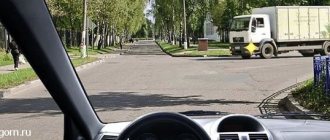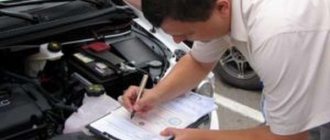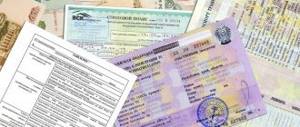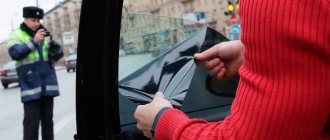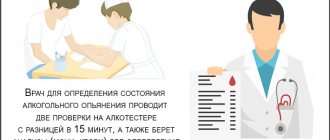In what case is it obligatory to give way to a tram?
In what cases is it necessary to give way to trams, and in what cases not? A tram always has an advantage over trackless transport except in three cases:
- when the tram moves to a switch turned on in an additional section at the same time as a red or yellow traffic light. In this case, the tram must give way to vehicles moving from other directions.
- when a tram approaches an intersection along a secondary road;
- when the tram leaves the depot and the tram tracks cross the roadway (clauses 18.1 and 13.6. Traffic rules)
The first case refers to the passage of controlled intersections, the second case - to the passage of uncontrolled intersections
Please note that at an equivalent intersection, the “obstruction on the right” rule applies only when driving around with trackless vehicles
Traffic rules: in what three cases does a tram give way to a car?
From this rule we can conclude that at an intersection a tram cannot take advantage of trackless vehicles only in 3 cases: 1) if at a controlled intersection it is prohibited from moving by a traffic light or a traffic controller; 2) if the tram moves along an additional section of the traffic light to the main prohibiting signal; 3) if the tram is on a secondary road, and the trackless vehicle is on the main road; Thus, the tram cannot take advantage in the three described cases at the intersection, as well as outside the intersection - when leaving the depot. Other cases should be perceived by drivers of trackless vehicles as situations where it is mandatory to give way to the tram.
Controlled and unregulated intersections with tram tracks
This requirement was written down in the “Street Rules”, which ended in 1973!!! The current traffic regulations have one requirement - give way to pedestrians! Therefore, we need to focus not on “soulless pieces of hardware”, but on people! If the tram is at its stop, but there is not a single pedestrian passenger who you could interfere with, you can calmly (but carefully) start moving! Movement along tram tracks Now about the use of tram tracks. Is it possible to move along them if the entire road is clogged with cars? How to make a U-turn, drive onto the rails or not? There are answers to these questions. If you open the traffic rules and carefully study all the paragraphs that contain information on this topic (clauses 9.6, 8.5, etc.), then an interesting conclusion can be drawn for the section of road between intersections.
What a driver should remember and the most problematic issues
Ticket 40, question 11
On equal roads, oncoming and passing traffic, a tram has an advantage over any trackless vehicle, and no driver should forget this rule. At the same time, you need to remember the three exceptions described above, in which electric vehicles give way to cars first.
At first glance, situations when you need to give way to a tram are clear and simple, but in practice, thanks to tram tracks, drivers face several more difficulties:
- traffic in the area of the tram stop (who lets whom through);
- movement on rails (is this permissible);
- intersections with tram tracks and the use of additional signs.
What you need to know when approaching a tram stop
Overtaking on the highway at an intersection. Overtaking at an intersection and possible fines. Is overtaking allowed at signalized intersections?
The most dangerous sections of the road, in the middle of which there are tram tracks, are stops, so the driver of a motor vehicle should assess the situation in advance and decide: should he stop and give way to passing passengers or not?
- If a special “island” is not allocated in the stopping area for waiting for public transport, then passengers remain on the sidewalk until the tram arrives, and as soon as it arrives and stops, they have the right to cross the roadway, and car drivers are obliged to stop and let them pass. In this case, you need to focus primarily on people, and not look at whether the tram driver opened the doors. Modern rules say that you need to give way to a pedestrian.
- If there is a special “island” for waiting in the stop area, then passengers wait for public transport there, and no interference should be created with traffic.
Fines
What threatens a driver who decides to break the rules? If he goes onto passing tram tracks, then there is no single penalty, because in a number of cases this is allowed.
For example, if a driver decides to cross a solid line, he will face a fine of 500 rubles. A driver who interferes with the movement of a tram is punished with the same amount.
To calculate the amount of the fine in a particular case, you need to use the traffic police fine table.
Stopping on the tracks is punishable by 3,000 rubles for Moscow and St. Petersburg, and for other cities this figure is half as much.
For driving on oncoming roads, punishment takes two possible forms: a fine of 5 thousand rubles or deprivation of rights for a third or six months.
If this violation is repeated, you will have to say goodbye to your rights for a year. If it was filmed by an automatic video recording camera, then the deprivation of rights is subject to a fine in the same amount.
If the departure is made to avoid an obstacle, the fine will be 1000 or 1500 rubles.
Amounts of punishment
Traffic rules knowledge test
Russian legislation provides for a system of penalties for moving along a rail track.
The penalties are shown in the table below:
| Description | Fine (in rubles) |
| Driving a car on rails crossing a continuous marking line. | 500 —1500 |
| Driving onto rails in the same direction under prohibitory signs. | 500 — 3 000 |
| Moving along the rails for a tram in the opposite direction. | 5000 |
| Driving onto oncoming rails due to the need to bypass an obstacle that has appeared on the route. | 1000—1500 |
| Stopping a car on the tram route. | 1500 — 3000 |
| Permitted driving on a passing rail track, creating interference for trains. | 500 |
What is the penalty for violation?
For violations in one way or another related to tram tracks, traffic police inspectors can be held accountable under various articles of the Code of Administrative Offenses:
| Violation | Regulation | Responsibility |
| Entry onto oncoming rails | Part 4 art. 12.15. | 5000 rub. or cancellation of the temporary residence permit up to six months |
| Driving onto oncoming rails when going around an obstacle | Part 3 art. 12.15. | From 1000 to 1500 rub. |
| Not allowing a tram to pass at a controlled intersection | Part 2 art. 12.13. | 1000 rub. |
| Not allowing a tram to pass at an uncontrolled intersection and in other cases | Part 3 art. 12.14. | 500 rub. |
| Failure to turn on the left turn signal before turning | Part 1 art. 12.14. | 500 rub. |
| A U-turn not from the tram rails when this is prescribed by the Rules, or, conversely, a U-turn from them when there are signs 5.15.1. or 5.15.2. | Part 1.1. Art. 12.14. | 500 rub. |
| Turning around a tram line separated from the road by continuous markings | Part 2 art. 12.16. | From 1000 to 1500 rub. |
So, tram tracks are one of the components of the road transport infrastructure. You can move along them only in cases established by the Rules.
U-turns are also allowed through them - but, again, in the absence of “Traffic in Lanes” signs and without interfering with the tram.
Nuances of movement, U-turns and turns on tram tracks
Sometimes circumstances develop in such a way that an acute lack of time provokes drivers to take risky maneuvers to make up for the deficit. Meanwhile, the Traffic Rules in the current version allow driving straight along tram tracks if there is a traffic jam on the road. You just need to follow some conditions:
- the actions of the motorist must not interfere with the movement of public rail transport;
- the rail bed must be in the same direction and be level or slightly below the road;
- You can drive if there are no signs 5.15.1 in front of the intersection. “Direction of traffic along lanes” and 5.15.2. “Lane direction”;
- if exit onto the tram tracks is not impeded by road markings (a solid line or markings regulating the directions of movement along the lanes).
You can only enter the oncoming lane to avoid obstacles (accidents, repair work, etc.), when it is not possible to avoid the problem area in any other way.
Left turn
In accordance with clause 8.5 of the traffic rules, before making a left turn or a U-turn, the driver is obliged to occupy the leftmost lane in advance, and if there are rail tracks on the left in the same direction, begin the maneuver from them. Naturally, the rails should not be significantly higher or lower than the road. Otherwise, they serve as a dividing strip. There should also be no signs 5.15.1. and 5.15.2.
It follows from this rule that if the driver starts a U-turn or a left turn away from the tram tracks, in the absence of reasons provided for by law, this will be an absolute violation of traffic rules.
U-turn
The rules do not define the term “reversal.” In practical driving, a U-turn is the process of moving a vehicle to the opposite lane from the original one: the driver first drives in one direction, then turns around and heads in the other.
The rules for turning on public transport rails are identical to the rules established for turning left:
You should take the far left lane (tram rails in this case), making sure that such a maneuver does not contradict the Traffic Rules: there are no signs regulating the direction of movement, road markings do not prohibit turning and turning, the rail bed is at the same level as the road. Make sure that the maneuver is safe: the lane of not only passing trams, but also of oncoming trams must be clear. If rail transport is in close proximity, it is better to postpone the maneuver and let the tram pass
You also need to pay attention to the distance from the car moving in the oncoming lane to the place of the planned turn.
Right turn
Turning right from tram tracks is prohibited (driving into a lane intended for oncoming traffic is charged). Only from the far right lane of the road.
U-turn at an intersection
In order to change direction at an intersection, you should follow the general rules for turning left and making a U-turn. The only difference in the maneuver algorithm is the presence of traffic lights or the work of a traffic controller separating traffic flows.
Based on clause 13.6 of the Traffic Rules, if a section of a traffic light is green or the traffic controller has built a combination that allows all vehicles to move, including trams, then trackless vehicles will have priority over cars. Accordingly, before making a turn and U-turn, the driver of the car is obliged to let the tram pass.
If the traffic light is equipped with an additional section that allows turns when the main signal is red or yellow, then in this case the driver must allow wheeled vehicles to pass, regardless of the direction of its movement.
In the video about the rules for turning around on tram tracks.
In what cases is it permitted to travel on passing tram tracks?
To begin with, it is extremely important to highlight clause 9.6 in the general collection of rules, which clearly defines suitable conditions that allow car drivers to move on rails:
- the tram lane runs parallel to the curb on the left side of the road in the same direction of travel;
- a detour is carried out to overcome an obstacle or due to road congestion (traffic jams, a huge number of other cars);
- a situation where it is absolutely necessary to make a left turn or turn the vehicle around completely.
Regardless of the reason, which boils down to one of the mentioned schemes, while on a tram line, car owners should not deliberately (out of ignorance) interfere with other traffic participants: classic rules do not allow occupying the tracks without a good reason.
What about oncoming rails?
It is worth immediately noting for all drivers that in this case, when turning, “oncoming traffic” is not allowed, so this situation falls into the category of strict prohibitions. Considering that, according to the rules of traffic rules of the Russian Federation, a U-turn is a full-fledged type of maneuver that changes the movement of traffic in the opposite direction, then you need to remain as careful as possible here. In practice, the oncoming lane can be used before or after the turn, but not directly during the maneuver itself.
It is necessary to note that when you are at an intersection where the rails change direction, such a ban is duplicated to any extent: it extends its effect to tram tracks with a bend, and the border between the intersection and the exit is quite ambiguous. Therefore, drivers should cross oncoming traffic only when it is possible to achieve a maneuver angle as close to 90 degrees as possible.
If we compare a U-turn at a controlled intersection and outside a given area, then in these situations, driving onto oncoming tram tracks is strictly prohibited according to Russian traffic rules.
At the crossroads
Analyzing the context of domestic traffic requirements and the very concept of “intersection” at various levels, specific cross-traffic through overpasses or tunnels is invariably implied. Even in paragraph 9.6. the term “level” should be taken literally when access to the rails is not limited and the coverage in the said area coincides with the condition of the roadway or differs only to an insignificant extent.
Thus, road designations 5.15.1 or 5.15.2 impose significant restrictions on transportation through the intersection along tram tracks. Here the driver must move to the lane before the exit to comply with all the recommendations of the signs located on the road.
In order to navigate through an intersection with nearby tram tracks without serious mistakes, you need to clearly understand which road the main traffic is on (main or secondary) , and whether it is regulated in a special mode.
When a certain intersection is controlled, the order of passage is determined solely by the characteristic signal of the installed traffic light. A driver planning to turn left or make a detour must certainly give way to the tram, as well as cars moving towards or to the right.
When a traffic light has an additional section in the format of an additional arrow, in a direction parallel to the activation of the yellow and red signals, then drivers of cars and trams are required to give way to vehicles moving on the other side. When the traffic controller allows a tram and a car to travel at the same time in the absence of the flashing arrow mentioned above, then the tram has advantages over the car, regardless of which route it follows.
In some situations, where the owner of the vehicle does not have the opportunity to figure out which road he is on, due to night time or difficult weather conditions, and there are no priority markers at all, he can drive the car, believing that he is driving on a secondary route. movements.
Situations in which a tram gives way
Indeed, almost always the tram goes first, and there are only three exceptions:
- if a car is traveling on the main road, and a tram is traveling on a secondary road. This situation is 100% compliant with the rule that when crossing unequal roads, the driver of a vehicle (any vehicle, without distinction between types (passenger, etc.)) walking in the secondary lane is obliged to give way to someone moving on the main lane regardless on what its further direction of movement is;
- if the path is cleared for a car by a green traffic light, and for a tram only the green arrow is lit simultaneously with the red or yellow signal;
- if the car is moving along the road, and the tram car is just leaving the depot.
In principle, having figured out in what cases a tram gives way to a car, problems in road traffic should not arise.
